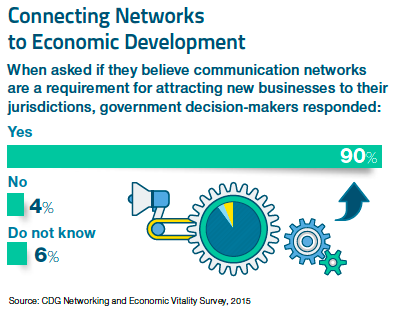Robust Network Foundation, Improved Economic Development

Introduction
The state of public infrastructure in counties and cities across the country receives a lot of attention, and rightly so. Reduced productivity and higher expenses associated with crumbling roads and bridges could reduce the U.S. gross national product by trillions of dollars, according to the American Society of Civil Engineers. But these vital resources are only part of the infrastructure story. Digital networks that also underpin municipalities are becoming more essential than ever for cultivating local business development, promoting eGovernment initiatives and delivering critical citizen services. In short, high-performance networks are every bit as important to the future strength of cities and counties as other infrastructure systems, including transportation, water and waste.
Recognition of this reality came through clearly in new research by the Center for Digital Government (CDG), which polled elected and appointed officials at local governments across the nation. Ninety percent of the responding leaders agreed modern networks are strategically important for attracting new business to their communities and for supporting other vital initiatives.
But warning signs also arose in the survey. An alarmingly high percentage of officials said their current network infrastructures don’t adequately meet the demands of modern service requirements. Even worse, a sizeable number of leaders don’t see network modernization as a top priority, and many elected or appointed officials don’t understand the vital role they play in driving commitments — and funding — for network modernization projects.
This CDG white paper provides a detailed analysis of these and other findings from the research and offers best practices for creating a foundation for the high-performance networks that will be required for the future.
Networks: The Cornerstone of Modern Government
High-performance wide-area networks (WANs) and local-area networks (LANs) provide a one-two punch for growth in states and local municipalities. Modern connectivity spurs local economic development by attracting new businesses that may want to tap the area’s workforce or lifestyle benefits, but it also requires a robust underlying technology foundation. For reasons like these, 81 percent of the government officials who participated in the survey said high-performance networks support economic growth and competitiveness.

In addition to seeing the link between network infrastructure and business development in their own areas, these leaders are likely influenced by third-party studies that correlate network investments and economic vitality. For example, a study sponsored by the U.S. Department of Commerce looked at 109 communities that tapped $4 billion in government grants for new broadband services. This spending generated increased annual economic activity of between $5.17 billion and $21 billion. In addition, the broadband infrastructure associated with these grants is expected to create more than 22,000 long-term jobs and produce more than $1 billion in additional household income each year for these communities.
Economic health isn’t the only payoff associated with modern networks. Reliable, high-speed connectivity also supports a new generation of essential eGovernment services, such as mobile apps, that streamline communication between citizens and agencies. In fact, 94 percent of the officials in CDG’s survey said the future of eGovernment requires ubiquitous network connectivity. In addition, more than two-thirds of the respondents said providing citizen services is a key benefit of networks, while 53 percent said networks contribute to the quality of life of local communities. Furthermore, one-third of the executives described networks as being important for effective emergency communications during a crisis.
All of these trends are playing out in Ogden City, Utah, a municipality of more than 84,000 people. It operates a modern network infrastructure that includes fiber cable connections, Ethernet-based WANs and free wireless Internet access to the public in the downtown area. “There has been a huge change in terms of our region needing a high-performance network infrastructure to compete for business not only with the cities around us, but also with other states and even countries,” says Andy Lefgren, the city’s IT operations manager. “Business development used to be influenced primarily by the available workforce or geographic location. Now it’s being driven by technology — companies want to know if we are close to high-speed network infrastructure.”
These types of networks go beyond supporting local businesses and workers. They help keep city public services operating efficiently and contribute to public safety. For example, fire and police departments increasingly rely on social media resources, such as Twitter, Facebook and Instagram, to stay in close contact with residents. This helps the police department locate people with outstanding warrants and gather information about open cases. “It’s interesting to see how citizens will respond faster using social media than with traditional telephone tip lines,” Lefgren says. “Officers are able to communicate with the citizens in real time.”
Ogden City received a welcome surprise a couple years ago when it sent out requests to network service providers to help with modernizing its networks. The city could upgrade its infrastructure without busting its budget. “Because of the highly competitive nature of network services today, we were able to contract for higher bandwidth than we had in the past, but for the same price,” Lefgren says. “That’s a huge deal for us because we can manage our expenses while still supporting the services our end users demand.”
Connectivity Gaps
The business case is clear that fast and reliable networks are a cornerstone of modern government. Unfortunately, many municipalities aren’t fully capitalizing on today’s advanced technologies. The officials who responded to the CDG survey acknowledged numerous shortcomings in their current communications environments, with 44 percent saying these networks don’t meet the challenge of contemporary service demands. Where are the gaps? When asked to name priorities for network modernization, a decisive 79 percent named enhanced security. This isn’t surprising given the volume and unrelenting frequency of cyber attacks on government IT operations. State CIOs responding to a survey by NASCIO ranked security as their top priority for 2015.

But while security is understandably top of mind for public sector IT managers, that’s not the only worry keeping them up at night. Given the importance of business development and eGovernment initiatives on economic growth and citizen well-being, network reliability has also become a prime concern. After all, businesses and citizens will resist using even the most modern digital services if they’re not available when needed. This helps explain why 72 percent and 57 percent of the respondents see high availability and resiliency, respectively, as network priorities.
IT departments in state and local governments continue to struggle with tight resources, which is why 59 percent of the leaders also considered ease of maintenance as a prime goal of modernization efforts.
Conflicting Priorities Impede Action
Based on the data showing the importance of networks and a clear understanding of where gaps exist, it would be easy to conclude that network modernization is high on public sector to-do lists. Surprisingly, that’s not the case. Despite today’s connectivity realities, a significant 46 percent of officials don’t rank network upgrades as a top priority.
Why the seeming lack of urgency? One explanation is the wide range of conflicting priorities — IT related and otherwise — that agency officials must constantly juggle. While rising tax revenues in some areas are beginning to loosen the most austere post-recession budget constraints, states and localities continue to maintain tight controls over purse strings. This means new IT initiatives must compete with a number of other areas vying for funds. In addition, one in five of the elected and appointed officials represented in the survey reflected what may be best described as an assumption gap: Their responses indicated they may take their networks for granted or they are unclear about their role in promoting network modernization projects. One possible explanation is that officials may view telecommunications as the CIO’s responsibility. While that may be true from a formal, org-chart perspective, it ignores an important reality — strategic initiatives, which today include the push for high-performance networks, require senior-level commitments from administrative leaders to deliver the resources required by local businesses and citizens.
A Modernization Game Plan
These results show that CIOs in state and local government face both a challenge and an opportunity. They’re challenged to convince officials outside of the IT department of the strategic benefits offered by the latest networking technology. The key is for administrative and departmental leaders to understand that a high-performance communications infrastructure is as vital to local growth, quality of life and safety as roads and bridges. When that happens, networking projects will have a better chance of getting the additional funding they deserve. At that point, CIOs have an opportunity to heighten their roles as strategic leaders within public sector organizations and make greater contributions to economic growth and citizen services.
How can IT managers achieve these dual goals? One-size-fits-all solutions aren’t the answer, but technology leaders can find their own path to success by focusing on four important steps.
Step 1: Start with a clear and detailed business case. Agencies that rely entirely on legacy, copper-wire networks can’t take advantage of the high bandwidth and easy scalability of fiber networks based on standards such as Ethernet. To understand the organization’s needs, IT departments should audit the existing WANs and LANs to determine what capacities are in place, the age of communications hardware and software, and where shifting workloads are creating bottlenecks and slowdowns. These investigations should also assess the security and reliability of the network, as well as the prevailing costs of network service contracts. All of these factors should then be merged with the enterprise’s near-term cloud strategy to determine what additional WAN services will be needed to support evolving software-as-a-service (SaaS), platform-as-a-service (PaaS) and infrastructure-as-a-service (IaaS) requirements. One other important factor is personnel resources. Many agencies struggle to staff, train and retain qualified networking experts, so the business case should spell out any potential savings possible from letting network service providers have a greater role in managing and maintaining network capabilities.
Step 2: Clarify the role elected and appointed officials play in network modernization. The reality is that without senior-level support, true network modernization is unlikely. Instead, funds may only become earmarked for routine upgrades to routers and switches at the end of their useful life expectancy, or for renewing contracts with existing WAN service providers. But this approach only “keeps the lights on.” To achieve the true strategic value of modern networks, governments need executive sponsors who can ensure today’s latest technologies will be implemented in timeframes that outpace competitors. The alternative? Watch other municipalities siphon away businesses and create more livable communities with the help of innovations in communications.

Step 3: With modernization in mind, IT managers should reexamine their choice of network service providers. In some cases, this may mean sticking with an existing vendor; at other times, a better balance of price and performance will be available from an alternative company. Either way, agency leaders should resist the temptation to build their own high-performance network. The right service provider partner will know how to implement fiber-network innovations for optimum performance and security. Just as importantly, they’ll be able to draw from best practices developed during dozens of previous implementations to keep upgrades on schedule and within tight budgets, while also ensuring as little disruption as possible to daily operations. The key is to take a fresh look at network services, expertise and innovations to determine who can best meet today’s modern requirements. Homing in on specific criteria can guide IT managers to the right partners. “Finding the best service provider often comes down to just asking the right questions,” says Ogden’s Lefgren. “One of the best things we did was to send out RFPs to a number of vendors. Once we did that, the possible solutions came to us instead of us spending time to go out looking for them.” Flexible technology is another important criterion when evaluating service providers. For example, while Multiprotocol Label Switching (MPLS) is the traditional option for WANs, today’s CIOs now have an important alternative. Ethernet-based WANs, also known as Metro Ethernet and carrier-grade Ethernet, make scalability easier than with older alternatives. This means that if an agency sees traffic starting to strain the 1 Mbps service from a main data center to a public works facility, for example, it merely contracts for additional bandwidth volumes from the Ethernet WAN provider in additional 1 Mbps increments, as needed, to 100 Mbps and beyond. “Gaining access to Ethernet capabilities was one of the deciding factors in our choice of WAN service providers,” Lefgren says. “Ethernet is a standard used throughout all types of industries, and we can scale it up and down according to what our internal users are willing to pay and the prevailing demand. We were also able to get the same amount of bandwidth at the price we were paying for the old T1 lines.” Another advantage of Ethernet WANs is they use a standard that’s familiar to anyone administering enterprise LANs. Thus, agencies can take advantage of internal expertise and management tools to control everything from data center routers and switches to WAN traffic. This is a valuable selling point for already strained state and local IT staffs that are looking for ways to simplify and consolidate their networking environments. In addition, a common standard means administrators gain a central view of network performance throughout the entire infrastructure to ensure closer control of workflows. When evaluating Ethernet WAN providers, agencies should determine which candidates carry certifications for Carrier Ethernet 2.0, issued by the industry consortium, the Metro Ethernet Forum. This ensures the WAN services provide additional Ethernet capabilities over and above what’s needed for LAN implementations. While there’s a lot for agencies to like about Ethernet-based LANs, this choice may not be the best option in all cases. For example, MPLS excels at supporting large numbers of connections. For the greatest flexibility, some public sector organizations will want to partner with service providers that offer a successful track record for both Ethernet and MPLS WANs. Service providers should also be evaluated for their understanding of total cost of ownership, including the capital expenditures involved and ongoing maintenance, to better serve and support the government market that is often plagued with budget constraints. Finally, a thorough evaluation of security capabilities is a must. Tools for easily encrypting the data that flows over WAN pipelines are table stakes; also look for advanced controls for access and identity management to keep cyber thieves from downloading sensitive information. The best service providers offer cyber-threat response centers to proactively spot new types of attacks and help clients take appropriate action.
Step 4: Outline new types of services and capabilities that will be possible once a modern network is in place. For example, agencies can increase the resiliency of their main data centers with backup centers. These may be created within district offices or other government facilities or by contracting with co-location and cloud providers. A modern, high-speed network will connect these resources to end users to avoid downtime if the core data center operations encounter disruptions. For the best performance and reliability, choose a WAN service provider that offers fiber-network connections to leading cloud services providers.
The Right Network Strategy for a Prosperous Future
High-speed, reliable and secure network services based on widely adopted industry standards are a necessity for state and local governments. With this foundation in place, they’re positioned to attract new businesses to their regions and satisfy constituents who rely on their government to deliver the latest eGovernment services and communications powered by social networks. Research shows that appointed and elected officials may not always understand the important role they play in supporting modern networks, but with a solid business plan and the right service provider, CIOs can lead the way through the connectivity crossroads.
Research identifies the vital role modern networks play in economic development and other strategic areas.
Locked Content
Click on the button below to get access
Unlock NowOr sign in to access all content on Comcast Business Community
Learn how Comcast Business can help
keep you ready for what's next.











